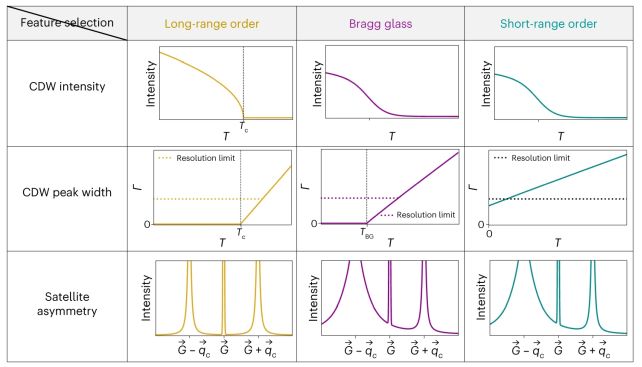A strange phase of matter that previously existed purely in the realm of theory has finally been detected in a real material.
It's known as the Bragg glass phase – a strange, seemingly paradoxical arrangement of atoms in a glass material where the particles are nearly as ordered as those in a perfect crystal. Scientists weren't even sure Bragg glass existed, but there it was, hiding in an alloy of palladium inserted between layers of terbium and tellurium (PdxErTe3).
The discovery, led by physicist Krishnanand Mallayya of Cornell University and published in Nature Physics, not only sheds light on the way materials can behave but demonstrates a powerful new set of techniques for probing the atomic structures of exotic materials.
The phases in question have to do with the way atoms and molecules are arranged. A long-range ordered phase is one in which the molecules in a crystalline solid are arranged in a neat, geometric, three-dimensional pattern. A disordered phase is one in which the component atoms are all jumbled up. Liquids are disordered in this fashion, but so are some solids, such as glass.
Between these arrangements, physicists predicted the existence of a third phase. That's Bragg glass.
Mallayya and his team thought they might find it in a material that contains a charge density wave (CDW), a phenomenon commonly found in two dimensional materials which describes the periodic modulation of a material's charge density. Think of it as a 'wave' in the way electrons are distributed.
For each of the three phases, the CDW behaves differently. For a long-range ordered phase, the CDW correlates with the material's structure continues indefinitely. For a disordered state, it breaks down within a finite distance. For Bragg glass, the correlation breaks down – but more slowly and over a longer distance than the disordered state, only seeming to disappear at infinite distances.

"The challenge," says physicist Eun-Ah Kim of Cornell University, "is detecting these distinctions from experimental data that also reflects real-life issues like noise and finite resolution of the experimental setup."
To detect the phase required a lot of work. First, there was the material; PdxErTe3 was carefully studied by scientists at SLAC and Stanford several years ago, and the researchers determined it would be suitable for their purposes.
To probe the structure of the material, the researchers sent their samples to the Argonne National Laboratory. There, the PdxErTe3 was bombarded with X-rays to measure the way the light diffracted off the interior of the material.
Finally, to pore through and analyze the absolute scads of X-ray diffraction data, the researchers used a machine learning data analysis tool called X-ray Temperature Clustering (X-TEC). This allowed them to probe thousands of CDW peaks – "the first time CDW fluctuations have been analyzed from more than a handful of peaks," the researchers note.
From CDW peak asymmetry, Mallayya and his team claim to have finally identified the existence of the Bragg glass phase, experimentally confirming its real-world existence. This represents significant headway into understanding this elusive phase.
Aside from confirming existing models, their techniques should also prove useful for future research: the X-TEC tool was able to extract features from the data with high precision, at a high rate, which promises many future discoveries to come.
"Using machine learning tools and data-scientific perspectives, we can go after challenging questions and track down subtle signatures through a comprehensive data analysis," Kim says.
The team's findings have been published in Nature Physics.
